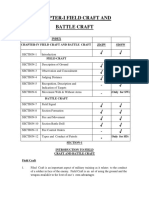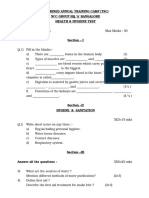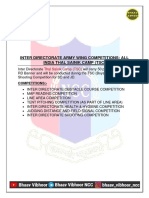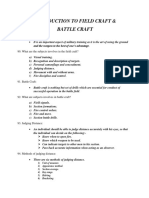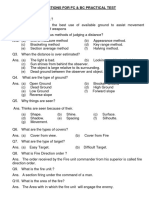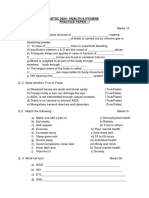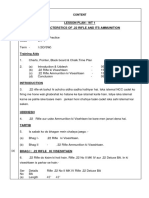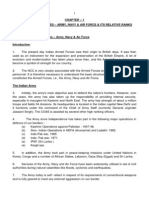0 ratings0% found this document useful (0 votes)
4K views114 pagesNCC TSC Notes
Important TSC notes
Uploaded by
SidCopyright
© © All Rights Reserved
We take content rights seriously. If you suspect this is your content, claim it here.
Available Formats
Download as PDF or read online on Scribd
0 ratings0% found this document useful (0 votes)
4K views114 pagesNCC TSC Notes
Important TSC notes
Uploaded by
SidCopyright
© © All Rights Reserved
We take content rights seriously. If you suspect this is your content, claim it here.
Available Formats
Download as PDF or read online on Scribd
You are on page 1/ 114
2SIKQ
CDI te ono efyhou ea War 2)
Nediko. Vijay Bhosale
TH Seni, Laer
CMahorashtra Directorate)
ee
s ; COMPETITIONS
ess Ordinary Journey 4
oe of @ months |
{a) SD Cadets. Fora group up to 2 cm and below
the catwill be awarded 40 points and thereafter 4 mrks
wallbe deuce for every "nal em.
upto 2! em —40marks
26-3 36
31-4.0
41-45. 8
465, oa
5.1-55~>20 ;
6.67.0
TATEOO thereafter 0Omarks
(b) SW/JW/JD Cats. For a group up to 2cms,
40 pts willbe awarded tothe cdt and thereafter 4 mrks
willbe deducted for every ‘one cm’. upto2cm-40mrks
2.0em 40marks
24-30 36
3.14.0 32
4.1-5.0 28
5.1-6.0 24
6.1-7.0 -20 =
71-80 167
81-9.0 12
90-100 08
101-110 04 thereafter OOmarks
(c). Application Fire. Max points are 40. The
award of points is as given
below foreveryhit- ~
~ Bull Satire
(i) InnerCircle - 6
(ii) Magpie - 4
(v) OuterCircle - 2
(d) Snap Shooting. Max pts will be 50, i.e., 10
points per hit. MARKS will also
be awajded if the hit breaks / cuts the outer line of the
picture.
NEGATIVE marks of -10 will be awarded. if fired after
the whistle 7sec.
(timed firing unsupported)
HEALTH
oe
HYGEINE
sTRUCTU. F ION OF THE HU i
{The human body is he greatest ot llcomplex machineries, In oder
{beaty out first ai, a, first alder should have basic ides otstructure |
+ _andfunetion of every pat ofhuman boey. Mary hws gan be saueey | i
Proper and timely fst aid can be rendered, ©
ISCUI
of Bones. The human body has 306 Bones of various
‘bones give shape and firmness to
Protects the vital organs Ke brain,
Cord. Benes can
{ called ‘spongy bone” and dens
called compactbone, Some bones.
and filed with bone marrow.
Ve Eiassiica
‘are hollows from inside
of Bones. Bones can be ciassified according to the'r
pe as under :-
x) Lona Bones. These bones are long and tubular and are con
to upper and lower limbs and rib cage.
jet Short Bones. These bones are short and tubuar and are found
in the ankle / wrists.
JS) Flat Bones. These bones are fi (iced) e.g. bones of
‘cranium (Skul) shouider and hips,
fo Inreqular'Bones, "Irregular or mixed shape, e.g, Vertebral 1
g Column: . a t
firmed
ee Sesamoid Bones The develo tere oe muses
body the flesh
t. The muscle form!
sible for body movment he
eras ander inecontl of nervous syst,”
Jetal Muscles, Voluntary muscles or skeletal
ae ese
araracies are atlached to tne surface of sees =
muscles form about 47 % of the body Se er
‘ther fiber type of sifiated tyoe. Most o aie
muscles pan from one bone to anotjer across ajoint an<
by contracting, they act upon the joints and produce
movements.
(b)Javoluntary Muscles. These are called involuntary muscles,”
because they are controlied by the autonomic nervous.
—eoS
latory Sysem. The circulatory system consists of the Heart,
Bicock Vessels and blood. Each time the heart contracts,
/ Slood is pumped along the blood vessels. It is therefore
‘oxygen, nutrients and other_substances are brought to
the tissues and the waste products and carbondioxide
formed by the tissue are constantly removed
“The Heartis the mostimy
's situated in thorax between the lungs and on to the
portant Grgan of biood circulation,
Each side is again divided into AURICLEs and
VENTRICLEs . Auricles are the receiving chambers.
. we Blood. The blood is also known as the ‘transport system Of
the body, and plays an important rolé in maintenance of
le. The total volume of blood contains - haemoglobin.
RBC. WBC, Platelets.
\(<)- Blood Wessels, Blood vessels are tube lke structure which
‘camTy blood all over the body forcitculation. These are of
three types :-
{) Attetits. These are the blood vessels which carry pure blood
from the hear || parts of the body.
\i)- Capillaries. These ar blood vessels which connect the
‘small arteries & veins. The exchasnge of oxygen and
nutrition with carbon di oxide by the tissue takes place!
the capittaries.
{G)_Aeins. These blood vessels carry impure blood to the heart
‘The main veins are called ' superior and inferior vena C2V4
~ Resoliatony System. Respiration ‘or breathign isa process bj which.
xygeN, obtained from fresh air, is absorbed into blo?
stream and carbon dioxide, fonned by the Ussue action.
is femioved from the blood and expelled into the ait, that
isthen expired, itis 2 process essentialto if. tinvol°>
the taking in of oxygen and giving out of carbon dioxide.
Vv
Z
The Main organs of respiratory system are Nose, PharynX,
Trachea, Bronchi, and the Lungs,
\ (paises sistem. Digestion is a mechanical and chemical process
by Which, complex food substances are converted inlo
simple substances so that they oan be e: ‘absorbed
by blood and uilized by the various tissues of tne BooY
20c0Fding to their requirements. The main organ> of
digestive system are mouth, Salivary glands, Pran/™*
ie cai te a
7
{
Esophagus, Stomach, Pancreas, liver, smaltintestine and
the large intestine,
‘System, Excretion is a process by which waste products
‘are removed out of the body. Among the organs that
contribute towards the elimination of waste products are
the skin, lungs, kidneys and the gastro intestinal tract.
La Skin. The skin covers the ext
omneaes
surface of the body. Waste
‘matterin the form of sweat is removed through perspiration
by the skin,
(0) Urinary System. The main organs of the urinary system are
()) Kidney. There are two bean shaped organs situated on the
posterior abdominal wall in the lumbar region. They act
as filters in the body, the waste
(i) Ureters. Ureters are wo lubes, which carrythe urine from kidneys
to urinary bladder.
shape varies according tothe amount of urine it contains.
Itstores the urine
ing from the floor ofthe urinary Bladder
to the exterior. tis used for excretion of the urine from
the body. )
\_ Blervous System, intemal Balance of the human body is maintained
C within normal limits by the nervous system and the
endocrine system, The nervous system may be sub
4 divided ito three marrportions
(a) The Central Nervous System. This consists of brain and spinal
fem. This forms the connection
between the central nervous systerm and the various
13
‘organs and muscies,
“The Autonomic Nervous System. itis an offshoot of the
‘central nervous system and controls the involuntary
functions of the vanous internal organs such as the
‘stomach, intestine bladder and also the tiny muscles of
the blood vessels and also controls the secretions ofthe
Liver arid Kidneys. A person is nether conscious forthe
—
‘normal activities of the autonomic system hor is he able
to control them,
CONCLUSION
Basic knowledge of our body systems allows us to understand the
field of health and hygiene with ease, This knowledge
provides us the basic framework cn which subsequent
knowledge and skils dealing with medical science can
be gainedin a progressive manner.
{ICAL AND MENTAL Hi
INTRODUCTION.
Earlier doctors defined health simply as ‘an
absence of disease oriliness’ Howerve, aftr the formation "
‘of world Health Organiazation (WHO) in 1848, healthis
defined asa Complete State of Physical, Mental & Social
well being' and not merely the absence of disease or
infirmity. The mind and body are single system. \
i i
PARTI: PHYS!
Physical health is the absence of disease and infirmity and itis
‘Elements of Good Health,Good Health is an essential condi
Characteristics of a Health
®&
‘assessed by taking health state measurements of the body.
purpose!
xistence. The main elements of good he:
sotdisease, (AAA CC PSS LO)
to work hard with efficiency and enthusiasm, i
Cheertuiness,
Courage.
Freedom from anxiety.
‘Self control and self confidence.
Sense of well being. &
Wholesome mental attitude.
tolay due emphasis on the
‘development of mental health of children. Any disregard to.
the sai ea fo mental disorder and conflicts, which
ultimately may bring frustration, misery and unhappiness,
Parents and teachers play a major role in providing an
environment in which children develop healthy mental
attitude,
Ocones WGA)
Notmal Appetite,
* Egq Hyalene. Though the majority of freshly laid eggs.
Contaminatin of food has to be observed from production to
handling, distribution and serving. The following are the
Important components of food hygiene :-
1 efficient vet
jon of milk may
‘Fr environmental factor. Following
‘aspects should be ensured to obtain clean and safe milk.
0
‘The animal endits suroundings should be healthy and clean,
The animal should be properly washed before mulching.
Milk handler should be free from any communicable disease,
Mik vessels should be totally clean, sanitized and kept
covered.
(¥) Water supply must be sate
™ Pasteurization. It is the heating of milk to such temperature
for such periods of time, as are requited to destroy any
pathogens withou!
alter taste, (Temperature 130 C and time 1 to 2 seconds.)
losis or food poisoning. The animal intended for
slaughter, must be subjected to proper ante mortem and post
mortem inspection. Good meat should neither be pale pink nor
deep purple nor should it be should not be silmy, Good meat
should be elastic to touch and should have agreeable colar,
Fish Hyqlene, Fish for human consumption ‘should be fresh, In
fresh fish, the glls are bright red and the eyes are clear and
proiminent. Consumption of contaminated fish may give rise to
fish polsoning
sterile inside
the eggshell may became contaminated by
the hen, The egg must be properly washed before cooking
20
Fruits and vegetables are an important.
read of pathogenic organisms, protozoan and
is and vegetables consumed raw must be3,
‘washed well before eating,
Eating Pi |
oe eee
imal shed, manure / soakage pits and other such
Rooms for storage of food should be wel
fat proof and should have adequate:
thable and non perishable items should be kept sec
should be strong and ea:
loclean,
€ should be collected in covered bins and removed regui
fater supply shoud be independent, adequate and safe,
Proper piace for cleaning of utensils should be provided, i
iene of Food Handiors,
(0) Complete medicat examination offood handlers mustbe dont |
the time of employment
}) Regular health checkups should be done |
i) Education of foed handlers should be regularly educated on heath
‘and Hygiene aspects.
‘They should be constantly reminded about hand washing,
{rimming of nails, covering of hair, wearing of overalls and’
covering mouth while coughing and sneezing during cooking,
PART II; SANITATION.
Definition, Sanitation means keeping the living ai
Suroundings neat and clean. This involves remo
nd its
waste
“= Sor the pater
(Y) Avoid over-crowdling,
{¥)_Proper Ventilation
(M1) Avoid spiting in public place
(Mth Proper Sunicht.
(©) Proper disinfection of ar
©
Prevention of Contact Disease,
Complete Segregation of Patient.
(®) No direct personal contact between patient and Staff.
(il) The early diagnosis will help in preventing the spread in the:
patient
M_Proper cispo
n of allaricles
i)
0
I help in eliminating larvae, Adequete collection,
temoval and disposal of sewage and wase water are important
wo
(i) Use of residual sprays like malathion.
(Use of mosquito nets, screening of doors and windows,
‘mosquito repellant and sun down sleeves,
(Control the presence of rodents and fleas in and around the
home.
(vi) Avoid contact with any species of wild rodents, especially sick
‘ordead rodents.
(vi) Not to handle sick or dead animals or animal waste.
30
‘The folowing preventive measures are necessary !oward ff these
diseases ‘-
ints are as under
Preferably shift patien
Ensure room confirms ta hygiene and sanitation standards ie,
adequate ventilation, sunlight and cleanliness.
.d person to take preentive measures like use of mask,
direct contactand hand washing before
() Clothing & Utensils used by patient to be cleaned / washec
separately.
Soltis
(W). Safe disposal
2.9. discarded
‘Stool, Sputum, Refuse
etc by burning.
ing Area or Premises. immedialely on detection
of a communicable disease, the souce of agents / germs
‘causing infection should be destroyed by following action =~
()_ Removal / Destruction of Garbage,
(@ Cleaning the drains & keep them covered,
(i) -Remove / Dry out waste water, :
() Spray malathion mixed in water (ration ; Malathion -1 ml, Water
Je 9 ini a ‘around premises. (Caution - Malathionis highly
}ous difect breathing / touch shi
seoeas should be avoided). wash
(Keep premises free of radents (rats), Stray dogs.
w
Use Mosquito nets, long sleeves, Screening of doors & windows.
x. OM
(@) Givearticial respiration.
(@) - Treatfor shock and burns.
28. It is caused due to interruption of the action of the brain through
some interference with the functions of the central nervous system.
(@) istStage- - —Delirium-When the restlessness of body: and
mind are present.
() lindStage - _ Patientresponds
maximum response to minimmum stimulus.
{c) Ilrd Stage - Semi - Coma - Patient responds to painful
‘only (minimum response tc
maximum stimulus).
It is a stage when the patient makes no
(@ IvinStage -
: response to any stimulus.
30. Causes of Unconsciousness of Coma.
(2) Head injury.
(b) _Hemorthage from brain. s
(©) Heartfailure.
(¢) Diabetic coma, Hepatic coma, Uraemic coma
© Excessive narcotic e.g. sleeping pills, morphine.
(0 Intracranial or brain infections like meningitis, encephalitis.
~ (g) Physical agents such as heat strokes, electric socks.
(h) © Epilepsy. .
id In Casualties of Unconsciousness.
40
33,
(@) Make the patient lle down with head turned to one side, pull
outhis tongue. => = pains
(bo)
(©) _Ifbreathing has stopped or is irreg}
ing, ensure fresh ait
iar, start artificial respiration,
() Keep the air passage clear,
(€) Nothing should be given by mouth. Remove false teeth, if any.
RTIFICIAL RESPIRATOIN,
Nielson Method.
(b) Schaefer's Method
(©) Mouth to Mouth Breathing.
Holger - Nielson Metho’
: Keep the casualty in prone position.
(2) Movement -1 : Go down on the left opposite the casualty’s
head, placing the right foot on the ground. Place the casualty’s
arm carefully above his head and keep them there during the
turn, Grasp his right upper arm and turn his face to one side
‘The mouth and nose must be unobstructed. The operator should
be 6" to 12" from the top of his head. Place the hands on
casualties back with the heel of the hand on the lower part of
the shoulder blade, the thumb on spine and fingers pointing to
casualty's feet. Keeping the arms straight rock gently forward
Until the arms are almost vertical, depending on the build of the
Casually using no special force. The movement takes 2 second
counting one, tio, This pressure causes expiration. This is
called movement 1.
(8) Movement - 2: The operator now rocks back counting 3 for
a4
2g-A large number of people have to be nursed at home either because
their sickness is not so severe or because on being discharged
from hospital they recover at home. It is here that skill in home
nursing comes in. A girl cadet trained in home ‘nursing can be an
asset to a family as she can by her care keep a patient's condition
from deteriorating and can hurse him back to health.
Nursing can be defined as functioning of annurse, in one's own home,
taking care of the establishment and reducing the intensity and frequency
of sickness to the barest minimum . The meaning of the word-NURSE is
—N _ Nobility, Knowledge
Qualities ofaNurse Agood nurse must possess the following qualities:~
(a) Honesty and Truthfulness: Anurse should be honest to her
profession. She should confess her mistake whenever she
makes any, and not risk the life of the patient by hiding it.
|
(b) Sympathy and Understanding: A good nurse should deal
with the patient with understanding and sympathy. She should
- sympathetically appreciate the pain and suffering of the patient.
—U_ Usefulness, Understanding
— R- Righteousness,Responsibility
S$ Simplicity, Sympathy
- E .Efficiency, Equanimity
44
(d) Atnight, flowers should be removed from the vases and fresh
flowers arranged in the morning,
Lighting:
a!
‘The light should not fall direct on. the face of the patient. It should
come from behind or the sides. There should be a shaded lamp on
the side of the patient. Theré should be another shaded light for the
nurse, so placed, that she can do her ‘job without disturbing the
patient. A well protected light can quite serve the purpose.
Ventilation
5.
6.
8.
Fresh air is essential for human existence. One of the important
processes of living is inhalation and exhalation. The dirty air exhaled
by the breathing process is replaced by clean, fresh air inhaled by
nostrils. The foul breath breathed out gets mixed up with fresh air
and is to be separated so that fresh air is available for the breathing
process to continue. _
Ventilation means the availability of pure, fresh air in abundant
quantity. It also means bringing inside a house or a place of work
plenty of sunlight. This is done through doors, window and open
spaces. For a good flow of air, there should be doors aad wine
opposite directions éxactly facing each other and at the sa
To be considered a well ventilated house the various
windows should face the direction of the sun light so
flows in, ample quantity to drive away all moisture and ¢
Lack of fresh ait, darkness and moisture cause
_ diseases such as tuberculosis and rickets.
Effects of Stagnant Air: Effects of impure air on
if there is no flow of fresh air, temperature would
10.
dhen A
: yper treatme i
(0)
(p)
Soles facing up. Raise the head, giving a backward bend to the
spine. Try to keep the spine bent backward as much as possible
without raising the navel. This asana is oq for the spine, the
chest, the neck and the head. Timings 20-30 sec. 4-6 times.
Chakrasana : Lie down on the back. Bend the legs at the
knees. Heels are close to the hips ahd sole touching the ground.
Bend the arms at the elbows and place them on the ground on
either side of the head. Place them in such a way that palms.
should rest on the ground and the direction of thé fingers should
be towards your feet. First raise your hips and waist, keeping
the legs straight. Raise the back as far as possible. This asana
helps in making the spine supple. Timing 1241 min, 1-2 times.
Sarvangasana : Lie down flat on the back. Raise leas from
the hips, push the truck up until legs are in vertical position.
The chin should press against the chest. The hands are giving
“ support to lower ribs. Hold this position upto 2-10 minutes.
Come back as slowly as possible. Do not give any jerks to the
body. This asana improves circulatory, respiratory and
alimentary systems of the body. Timings : 1/2 - 1 minute.
‘Halasana : Lie down flat on the back. Place the arms by sides
along thé hips, palm facing the ground. The legs are raised up
ina single motion and put down behind the head keeping knees
unbent. The chin should touch the chest. In this exercise, the
legs will remain straight and breathing should be normal. Hold
this position for 30-50 seconds. This asana stimulates blood
circulation and makes the spine flexible and elastic.
: fi inoizulonod
gesb pniven szinexs to rmot.,berinse2si llaw ,balzo} 9mit 8 2i spoY
to else eyit:zoq bns qasb onT -esnohevo Issibem bns euoigils:
* \d isHted jlet-ed nso tsnoititos1q 6 to bnim bns ybod srt no SpOY
Ofni tisemid eetsitini nozisq s gonO asriosel bsnist S19bnu fi pniob
Mosteb of mid 101 sluoittib 2i ti
‘620\ to bhow Isuthiqzooibam arit
Ji moi tleemin
- eT Sic:
Sg Tene ery ren owung Gown |
eat front ae) a cel
between thigh yuna she shoul de Tsévéral time
() Followme Right arm swung from rear to front above,
the shoulder, in ‘over arm bowling! fashion.
(k) ‘Lastorder Right hand to salute, then arm raised 2 |
incompleted air finger extended. ‘
() Last order Not Both hands, cupped behined the ears.
understood ea i t
(fn) Commanderto Right arm to the side at 45 degrees to, t
the
close body, first clenched.
(n) Enemy in sight * Both arm waved on sides ‘Bird fashion’
specificnumbers ~ followed by numberof fingers held up.
(0) Enemy Approaching Both hand open, palm inwards at waist
level, with inwards scooping motion.
‘(p) Enemy position Both hand, first clenched,,raised to
suspected shoulder level, followed by indication of
direction.
(q) .Enemy LMG firing Right hand thumb down vsignel,
(9 Engage target _ Both hands clasped above the head oa
. by Fire fashion).
(s) Attack Punching motion with Right or Left ane
aes according to direction of attack.
() Closedto Glose sign followed by both hi hands cla
Rendezvous in front of bedy at waist level.»
- (v) Infahtry obstacle Both hands crossed in front of body al
ahead waist, palm open: downwards.
f Sia with Weapons
\% (@)_ Enemy in Sight in » Rifle held above the he
h ‘small number ground, muzzle in the dir
é Cense Prer. Bring the right
- fore-rm |
y
te Move it. right
HIT U 4m
; | Dregmmunitions: Denes bod,
ef . enemy. downward
(b). Enemy in Sight in AN pat (a) abeve! ut anmoves oo
large number and down several times.
(c)_ Advance ; -Both arms raised to form the letter 'U’
ct |
Bue SR ean olen,
i
| = s)enem: 6p; Rifle above the gho
|
| 4 @ Cautionary Blast A short blast to ve attention toa -
: . signal or order about to be given.
i (b) TheAlarm Blast A succession of alternate long and
short whistle.
(c) Enemy Aircraft A succession of short blasts.
(d) Enemy Aircraft Two long blasts Tepeated at Interval of
departed five seconds.
d When cre tS. useay?
: eld Signals as means of hiving orders.
Field Signals are alternate means of giving orders and control troops
when voice contis not —
possible. Control over troops deployed could be excercised better
by field signais than by voice control.\There are venous Rem
when voice control is not possible. They are
(a) Battle Noises.
(b) Need for silence.
(c) Intervening distances are too large.) _
all round and aircraft fling with high speed.
s0 much hoise that voice contro! may not a
are caried out in utmost silence, eg:-
(2) Ambush,
Other.m: thods of communication: Besides field Signals th
are‘various means of communication in the Army which can ed
used depending on their availability. The other methods of int
communication available to us are :- =
(a) Radio. _ Itis avery effective and dependable
means of communication and very useful while on movement. Pre-
fixedsignals can be used in-the form of Pressing the presser
switch: Itis normally used between commanders or from higher
HQ tolower HQ or Vice Versa. However it is susceptible.to en
interruption and jamming. i
‘
(b) Dispatch Rider. The dispatch rider may be either ona
motor cycle or on a bicycle. They are used to carry highly
classified messages like marked maps and sketches or orders.
(c) Runners. They can carry verbal/written
messages. They are quickest over short distances but where
visual inter communication is possible, Keep use of runners to -
the barest minimum. The use of runners should also be avoided
for the following reasons :
() Toavoid unnecessary casualties.
(i) Toavoid unnecessary movement.
(iii) To avoid unnecessary fatigue.
Field Signals by Day. Some of the visual signals used
during the day are. flags and mercury coated mirriors. They
ue 5
are'very useful in hilly terrain. Flags are very ‘effectively:
used by Navy on board a ship.
(a) Flags.
(b) Mercury coated Mirriors. 3
(c) Smoke. We have the'smoke ammunition
with’'51mm Mor, 84mm RL, 81mm Mor and some arty
. equipment. This could be used to give signals. One
80
CCNCLUSION
The fighting eficiency of a unit sub unit
depends on sound communication system of which help
commanders at all levels to exercise comand and control.
effectively. Every commander must influence the’battle by
his personal touch which is achieved by good signal
* communication. At section/platoon level, (
directly influences the battie by the us
Victory in battle will come to that sectio
Remember always to use discretion wh
Denot unnecessary movement and no
maxim (if speech ik
tind.
silver, silence is q
edika .
ee General a ‘ ’ Vijay Bhosale
JUDGING DISTANCE
4, Accurate fire with any weapon depends on the correct judging of
‘distance. Although a cadet is not normally fequired to open fire at
- range over “goyards he Must be able to judge distance up to about
—teeoyards, sothathe- © ; ‘
7) Knows when to open fire.
SPSS MNO Cg
3 a) Can indicate targets to Seow arms or to men in a sub-
unit. =
“ Can pass back information accurately when acting as an
observer.
An Individual should be able to judge distance accurate with his eyes so
. thatthe individual.
~ (a) Knows when to open fire.
a - Knows which weapon to be used (51 mm mortar, rifle or carbine).
(c) Gan indicate targets to other men in his section/direc!
‘sp weapons. —
(a) Pass back accurate information when acting a:
ee
- | (ese METHOD OF JUDGING DISTANCE
2. The following are the six methods of judgi 9 dis
(2) Unitof measure.
Appearance method.
Section average. ~
Key range
Hating,
. Bracketing.
jc a,
| then accepted as the distance. Here caution must be exercised in c
the estimation of a few who may foolishly over estimate the distance
Here cautions must be exercised in the estimation of a few who -
May foolishly overestimate the distance.
‘This method may be resorted to under the following circumstances:-
(a) Ample timeis available.
(0) Judging of distance is made difficult by mist or darkness.
(©) Judging of a long distance is involved e.g. beyond 400 yards.
Kev Range
6. ifthe range of the certain object is known, distance to other objects
an be found in relation to the known range. This method is called
XeyRange:method. €G- Milestone, cela
Hailving Stand.
9. Anobject is selected half way between the observe and the target,
the distance to the selected object is see end doubled to get the
distance to the target.
Sracketing
10. The observer works out the maximu n
distance of the object and then accept
€.g. maximum possible distance 10(
distance 500 yards therefore estimated
greater the range wider.the bracket. {
be ples than 300 yards.
Practical Hints _
- During Night. Judging distance at night
The only suitable method is the ‘Ke
~ prominent objects. and work out thei
e ey light.
a
_CARDINAL POINTS AND FINDING NORTH
General
1: Pines pure daws tenant one ar compas Nort, Sut, :
East and West are known as the cardinal points. : ‘
Be Ifthe Nori pomtieekeras 0 Degrees the angle which East
forms with itis 90 degrees. or aright angle. The angie formed by the
South point, being twice as large, is 180 degrees, and the West point
forms an angle of 270 degrees. If the angle is measured all the way
round the circle back again to North, it will be found to be 360 degrees.
Types of North
3. There are three type of North points:-
(a) TrueNorth - The direction of North pole ©
from the observer.
(b) Magnetic North- It is the point to which an -
accurate compass needle points, when freely suspended. sa
ot
(c) Grid North
North South grid lines on a map point.
; 5. ‘Time. The Variation is not
_and even the change each yearis D
Beeey asia
with GPS equipment receive transmission from at least a few of the
satellites and are able to discern Very precise positioning data.
-10. — The'first GPS satellite was launched in1974 and the 24" was
Taunched in1994. The new satellites are etiodically launched to replace
the ageing ones, GPS in funded by and controlled by the United States,
“DepartmentofDefence. i
Mma. The application of GPS isvery broad and number of users is
increasing dramatically. With improved technology, small portable GPS
receivers have become very handy and accuracy is remarkable. These
devices are used by fishermen and hikers to navigate. Today, many
vehicles are equipped with GPS to help the drivers to navigate. In the
Armed Forces, GPS has made navi igation very easy. All aircraft, ships
and specialist vehicles are Equipped with GPS. In the Army, GPS is
commonly used in battle fields and insurgency-affected areas, Itassists
troops to navigate in thick Jungles, mountains and deserts. GPS is also
used to guide missiles to Pre specified targets.
SETTING A MAP. FINDING OWN POSITION AND
NORTH :
Definition». ; 2
ils A map is said to be set or oriented when itis placed such that
| it corresponds directly with the ground i.e. when tre NORTH onthe
map points totrue NORTH on the ground, Obviously it is easier to
Tead a map| when the objects ont are pointing in the same direction as
* the objects.on'the ground.
NORTH line on the map ispointing in the direction of magnetic
- NORTHas indicated by the compass needle.
4 (a) Withouta Compass when Own Position isKnown
: 118
(ad) Enroute, ensure you are marching
correctly. d
(ae) Be careful while measuring distance
in steps.
(af) _ If youdeviate while crossing an”
obstacle, choose a mark across the obstacle,
‘After crossing the obstacle come in line of:
themark and recommence marching,
(ag) If you reach a wrong place, come
back to the start point.
Night March
2 When navigation party moves at night with the help of compass
and night march chart, this is called night march.
(a) During Moonlit Night. If you havea comipass, you
Can select two important land marks on the given bearingina ~
line and march on the same bearing and line_ Repeat this till
youreach the object.
(b) - Starlit Night. Select a Prominent star at 30 degree
onthe horizon on the given bearing. Selecta landmark in line of
the star, March in line of the star and the land mark for
approximately 15 minutes, Then select another star in the same
bearing and repeat till youreach the object, :
(c) y : Cloudy Night. Make a Person march on the given
bearirg to a distance where he can be seen, Then the person
holding compass marches, measuring the distance, First ‘Person.
125 ‘ Say
10.
at:
12.
13.
14,
» 15.
16.
_ 17.
TSC GIRLS (IGC) QUESTIONNAIRE
FIRST AID & HEALTH AND HYGIENE
Fracture may happen in fragture sf Ribs or Spine
The knot used to secure the ends of a triangular bandage is.
The bandage used for bandaging at or in the neighbourhood of a |
joint such’as knee or elbows.
The bandage used when the whole sclap is to be coveredis__
The is a modified figure of 8 used for bandaging the shoulder,
groin, thumb or hip.
In case of fracture of Thomas Splint is applied.
The knot used when triangular bandage is improvised from 4
handkerchief is
A is the wrenching of the ligaments end tissues around
the joint. :
i means displacement of one or more bones ata joint.
A is the over stretching of a muscle.
A crepe bandage is used for. around the joints.
Blood from capillaries comes out as a =
A is an area where artery can be compressed against
the under lying bone to prevent flow of blood'beyond that point.
While treating a patient for Rabies, the dog must be kept under
-observation for___ days
The bite of a scorpion should be treated as a bite.
Anything which interferes with respiration producing irregularity in
breathing produces a condition known as
The first stage of unconsciousness is called
; > 9:
3)
4)
a
8)
9)
Camouflage'is done for.
(2) Judging distance (b) Concealment (c) Section Formation (a)
Platoon Formation, NS
While indicating Indicate direction first and then range.
(a) Target (b) Landmark (c) Reference point (d) object
During night the best Method for judging distance is
method :
(a) Halving (b) Bracketing (c) Key fange (d) Section Average
AtL_____syards blade of the fore Sight covets a kneeling man
(2) 150 yards (b) 250 yards (c) 350 yards (d) 500 yards
Under, method the average of the answers given by the
whole section is accepted as the distance
(a) Appearance (b) halving (c) Section average (d) Bracketing method
When are distances overestimated?
(a) Looking up hill (b) the object is large (c) Light is bright
(d) Lightis bad
When are distances under- estimated?
(a) Lying down (b) the object is small (c) If there is dead ground
between the object and Observer (d) Looking through a street
(10) Unit of measure chosen under unit of measure method
is. 100, yds.
You might also like
- Inter Directorate Army Wing Competitions: All India Thal Sainik Camp (TSC)No ratings yetInter Directorate Army Wing Competitions: All India Thal Sainik Camp (TSC)1 page
- NCC B' Certificate - Practical Exam Questions67% (6)NCC B' Certificate - Practical Exam Questions6 pages
- Special Sub Chapter 3... Field Craft-Rotated100% (1)Special Sub Chapter 3... Field Craft-Rotated26 pages
- Question Paper of NCC C Certificate Exams PDF75% (4)Question Paper of NCC C Certificate Exams PDF14 pages
- Introduction To Field Craft and Battle Craft100% (1)Introduction To Field Craft and Battle Craft15 pages
- Lesson Plan: WT 1 Characterstics of .22 Rifle and Its AmmunitionNo ratings yetLesson Plan: WT 1 Characterstics of .22 Rifle and Its Ammunition3 pages
- NCC B & C Certificate Exam Notes - Part I II III & IV-3-1No ratings yetNCC B & C Certificate Exam Notes - Part I II III & IV-3-185 pages
- Question Paper Solutions of NCC C Exam 200950% (2)Question Paper Solutions of NCC C Exam 200914 pages
- Human Body - Hygiene - Sanitation - Physical and Mental HealthNo ratings yetHuman Body - Hygiene - Sanitation - Physical and Mental Health57 pages











